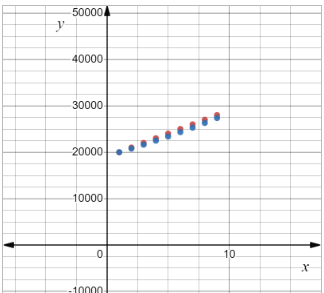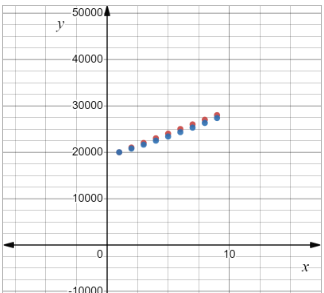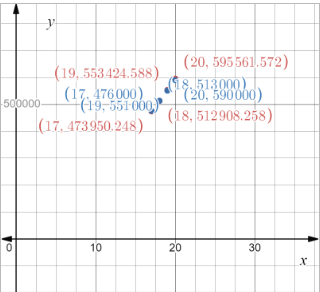
i.
To identify: The rules giving the salaries a and b, in the nth year at companies A and B. respectively. Tell whether the sequence represented by each rule is arithmetic, geometric, or neither.
Two companies, company A and company B, offer the same starting salary of $20,000 per year. Company A gives a raise of $1000 each year. Company B gives a raise of 4% each year.
Company A is arithmetic and company B is geometric.
Given information:
The given terms are.
Explanation:
Put the value of
Because the salary at company A is raised by the same amount each year, the sequence is arithmetic.
Put the value of
Because the salary at company B is raised by the same percentage each year, the sequence is geometric.
Therefore company A is arithmetic and company B is geometric.
ii.
To identify: Drawing Graphs Graph each sequence in the same coordinate plane.
The value of the sequence and plot the point on graph.

Given information:
The given terms are.
Explanation:
Consider the given sequence.
From above explanation.
Draw the table calculate the value of
Draw the graph following the table value.

iii.
To calculate: Sums For each company, find the sum of wages earned during the first 20 years of employment
Company A
Company B
Given information:
The given terms are.
Calculaation:
Put the value of
Put the value of
Put the value of
iv.
To identify: How many years the total amount earned at company B is greater than the total amount earned at company A. Use a graphing calculator or spreadsheet
The required years are
Given information:
The given terms are.
Explanation:
See that the first value of
It mean that the first year such that the total amount earned at company B is greater than the total amount earned at company A is the

So,
Chapter 7 Solutions
Algebra 2: New York Edition (holt Mcdougal Larson Algebra 2)
- 9:43 AS く Akbar © Printed in the United States 15) Scale: 1 cmal unit on both axes .ill 64% The graph above shows a straight line QT intersecting the y-axis at T. i State the co-ordinates of T. ii Calculate the gradient of QT 16) iii Determine the equation of QT. A (-1, 9) ||| i L Г (5 marks)arrow_forwardPls help.arrow_forwardPls help.arrow_forward
- eric pez Xte in z= Therefore, we have (x, y, z)=(3.0000, 83.6.1 Exercise Gauss-Seidel iteration with Start with (x, y, z) = (0, 0, 0). Use the convergent Jacobi i Tol=10 to solve the following systems: 1. 5x-y+z = 10 2x-8y-z=11 -x+y+4z=3 iteration (x Assi 2 Assi 3. 4. x-5y-z=-8 4x-y- z=13 2x - y-6z=-2 4x y + z = 7 4x-8y + z = -21 -2x+ y +5z = 15 4x + y - z=13 2x - y-6z=-2 x-5y- z=-8 realme Shot on realme C30 2025.01.31 22:35 farrow_forwardUse Pascal's triangle to expand the binomial (6m+2)^2arrow_forwardListen A falling object travels a distance given by the formula d = 6t + 9t2 where d is in feet and t is the time in seconds. How many seconds will it take for the object to travel 112 feet? Round answer to 2 decimal places. (Write the number, not the units). Your Answer:arrow_forward
 Algebra and Trigonometry (6th Edition)AlgebraISBN:9780134463216Author:Robert F. BlitzerPublisher:PEARSON
Algebra and Trigonometry (6th Edition)AlgebraISBN:9780134463216Author:Robert F. BlitzerPublisher:PEARSON Contemporary Abstract AlgebraAlgebraISBN:9781305657960Author:Joseph GallianPublisher:Cengage Learning
Contemporary Abstract AlgebraAlgebraISBN:9781305657960Author:Joseph GallianPublisher:Cengage Learning Linear Algebra: A Modern IntroductionAlgebraISBN:9781285463247Author:David PoolePublisher:Cengage Learning
Linear Algebra: A Modern IntroductionAlgebraISBN:9781285463247Author:David PoolePublisher:Cengage Learning Algebra And Trigonometry (11th Edition)AlgebraISBN:9780135163078Author:Michael SullivanPublisher:PEARSON
Algebra And Trigonometry (11th Edition)AlgebraISBN:9780135163078Author:Michael SullivanPublisher:PEARSON Introduction to Linear Algebra, Fifth EditionAlgebraISBN:9780980232776Author:Gilbert StrangPublisher:Wellesley-Cambridge Press
Introduction to Linear Algebra, Fifth EditionAlgebraISBN:9780980232776Author:Gilbert StrangPublisher:Wellesley-Cambridge Press College Algebra (Collegiate Math)AlgebraISBN:9780077836344Author:Julie Miller, Donna GerkenPublisher:McGraw-Hill Education
College Algebra (Collegiate Math)AlgebraISBN:9780077836344Author:Julie Miller, Donna GerkenPublisher:McGraw-Hill Education





